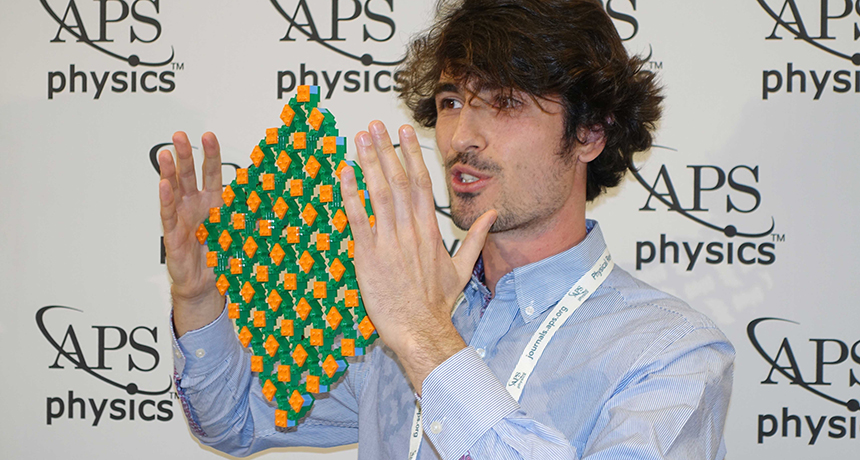Playing with building blocks for metamaterial design

BALTIMORE — Metamaterials, among the most intricate and skillfully designed configurations of matter ever devised by science, could be improved with the help of Legos.
Famous for their use in cloaking devices, metamaterials are artificial structures that play unnatural tricks with light and sound and other vibrations. Scientists have investigated the use of such materials for soundproofing rooms or protecting buildings from the shaking of earthquakes, among other things. But to do their jobs, metamaterials must be properly designed and fabricated using precisely manufactured components. Testing ideas for new metamaterials is therefore time-consuming and expensive.
So Paolo Celli and colleagues at the University of Minnesota sought alternatives. They considered 3-D printing, Celli said March 15 at a meeting of the American Physical Society. But the printing process can be slow and the “ink” isn’t cheap, so they rejected that idea. “That’s when we thought, ‘Why don’t we use Lego bricks?’” he said. Legos are relatively cheap and can rapidly be rearranged into all sorts of configurations.
Celli and colleagues arranged Lego bricks on a base plate attached to a wooden frame and investigated how the arrangements influenced the way vibrations traveled through the plate. For some arrangements, certain vibration wavelengths could not be transmitted. Manipulation of the Legos allowed the scientists to determine what processes created the forbidden wavelength zones (known as bandgaps), providing valuable data for future designs of real metamaterials.
Further experiments showed how Lego arrangements could identify metamaterial architectures that might provide a shield for buildings at risk from earthquake waves. “We might be able to design a metamaterial shield that might block some frequencies that can be harmful to that structure,” Celli said.
Ahmed Elbanna, a materials researcher at the University of Illinois at Urbana-Champaign, called the work with Legos exciting and said in principle it could be applicable to designing metamaterials for some applications. He said he was “a little bit more skeptical” that it could result in useful earthquake protection.
Celli emphasized that the motivation behind the work was not solely to produce better metamaterials. “We’ve been looking for an agile and versatile experimental platform,” he said, “but we were also looking for something that people can relate to…. We think that this platform is probably very powerful” for promoting this branch of physics to a broader community.
Asked if he played with Legos as a child, Celli replied, “a lot.”